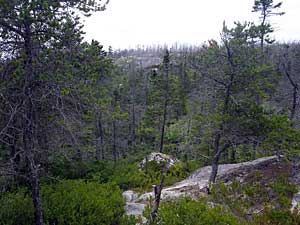Invasive multiflora rose (Rosa multiflora) is a threat to the wetlands/watercourse margins in particular. Appearance of other, non-invasive exotics such as clover, dandelion and plantain on the barrens are indicative of some loss of Ecological Integrity. I have some concern that continued loss of Ecological Integrity could result in substantial change in the “nationally unique and globally rare” Jack Pine/Broom Crowberry communities.

Purcell’s Cove Conservation Lands are disturbed
periodically by fire (burned stands can be seen in the
distance, unburned Jack Pine/Broom Crowberry
Barrens up close) but there were no exotic species in a
2012 survey. What about now?
Click on image for larger version
Post & related pages by David Patriquin
June 13, 2021
A remarkable feature of the Backlands is that there are very few exotic plant species within in its confines.
Exotic species (also described as alien, introduced or non-native) are those that have arrived in NS since European colonization, as opposed to native species which “been observed in the form of a naturally occurring and self-sustaining population in historical times”. (However species that are native in adjacent areas like N.B. but that have been recorded here only recently would be considered “native”.) View Definitions
Roughly 1/3rd of the approximately 2400 vascular (higher) plant species in Nova Scotia are species of exotic origin. Most of these exotic species are species of human-disturbed habitats such as clovers , plantain and Queen Anne’s lace. Many arrived here with the early settlers, but exotic species also continue to arrive either through deliberate introductions (e.g. for gardens) or inadvertently and some of them to naturalize (“go wild”).
The general absence of exotic species in the Backlands is good news because it is an indication that the plant communities in the Backlands have a high degree of ‘Ecological Integrity‘.
Fortunately, very few exotic plants become invasive and invade and disrupt native plant communities. Currently about 15 species are in the invasive species lists for NS. In areas just outside of the Backlands, only two – Multiflora rose (Rosa multiflora) and Japanese Knotweed (Polygonum cuspidatum & P. sachalinense) have a significant foothold right now.
I spotted one of those – Rosa multiflora (Multiflora rose) within the Backlands, on Lawsons Brook just below the dam on Williams Lake earlier this spring. This was concerning, as R. multiflora can be really disruptive in wetlands and be essentially impossible to remove; it is now well socked into some wetlands in the Frog Pond area for example.
So I think we should be on the lookout for R. multiflora, and quickly remove it or cut it back where it is just getting established to prevent massive infestations in the Backlands. (Once it get’s well established it’s essentially a dun deal.) R. multiflora is most readily spotted in early July when it is flowering, so coming up.
What to do if you spot one in the Backlands? Well to begin, please report it on iNaturalist and it will appear on a project page for Rosa multiflora in the Backlands. (Also, the iNaturalist community will confirm, or not, the identification.)
At the moment, it appears that there is no coordinated strategy for dealing with invasive plants in the Backlands, or even, it appears, within HRM or in NS. The NS Invasive Species Council is just getting going and hopefully will fill the void; it has a form for reporting invasive species.

Dandelion by Jack Pine on the barrens,
May 17, 2021
Could loss of Ecological Integrity
suggested by the presence of exotics,
if continued, lead eventually to very
different communities?
Less concerning but at the same time, indicative of some degradation of the Ecological Integrity of the Backlands, are other exotic plants that are not considered “invasive” such as dandelions, plantain and clovers. I have begun to see some of those by trails on the barrens by Governors Brook.
I have some concern that loss of Ecological Integrity suggested by the presence of exotics, if continued, could lead eventually to very different plant communities on the barrens; those barrens which now host “nationally unique and globally rare” Jack Pine/Broom Crowberry barrens.
Read more on the topic on this website under
Exotic & Invasive Plants, and its subpages:
- Rosa multiflora
- Governor’s Brook/Mac Run Barrens
- Definitions
- Lit & Links
- Invasive species in Nova Scotia
I suggest that the appearance of Exotic and Invasive plants in the Backlands is an issue that (a) deserves more investigation/monitoring, and (b) needs to be discussed within and among the various organizations that have an interest in the Backlands, perhaps within the context of developing a broader conservation & fire management strategy.

